Eastern Sicily is a treasure trove of cultural riches, natural beauty, and gastronomic delights, and should be included in your Sicily Itinerary. From the charming hillside town of Taormina to the ancient streets of Syracuse, the fiery landscapes of Mount Etna, and the medieval town of Noto, this part of Italy offers unforgettable experiences for every traveler. Planning your Eastern Sicily itinerary with Taormina and Syracuse as your bases allows you to explore these wonders at a leisurely pace. Here’s how to make the most of your Eastern Sicily travel itinerary.
This post may contain affiliate links. If you make a purchase through these links, I will earn a small commission at no additional cost to you. I will only recommend products I have personally used. Read the full disclosure here.
Our week-long itinerary includes 3 days exploring Taormina, with a day trip to Etna; 3 days discovering Syracuse and Ortigia, with a day trip to Noto; and 1/2 or 1 day in Catania, depending on your flights.
East Sicily Travel Itinerary
- Day 1 Morning: Exploring Taormina
- Day 1 Afternoon: Villa Comunale, Mazzarò Beach
- Day 2 Morning: Madonna della Rocca Sanctuary and Castelmola
- Day 2 Afternoon: Isola Bella
- Day 3: Exploring Mount Etna
- Day 4 Morning: Archaeological Park of Neapolis
- Day 4 Afternoon: Pista Ciclabile Siracusa
- Day 5 Morning: Ortigia Market and Duomo
- Day 5 Afternoon: Ortigia
- Day 6: Day trip to Noto
- Day 7: Catania
If you have more time, see How to Plan your Perfect Week in Western Sicily Away from the Crowds.
3 days in Taormina
Day 1 Morning: Exploring Taormina

Start your day with a traditional Sicilian breakfast at the Bam Bar—granita with a brioche. It is worth waiting for a bit to get a table outdoors for the atmosphere. If you haven’t tried Granitas before, it is similar to a sorbet. My favorite was pomegranate, though you’ll have a long list to choose from. Explore the neighborhood after breakfast. The house in the photo below is just around the corner from the café.
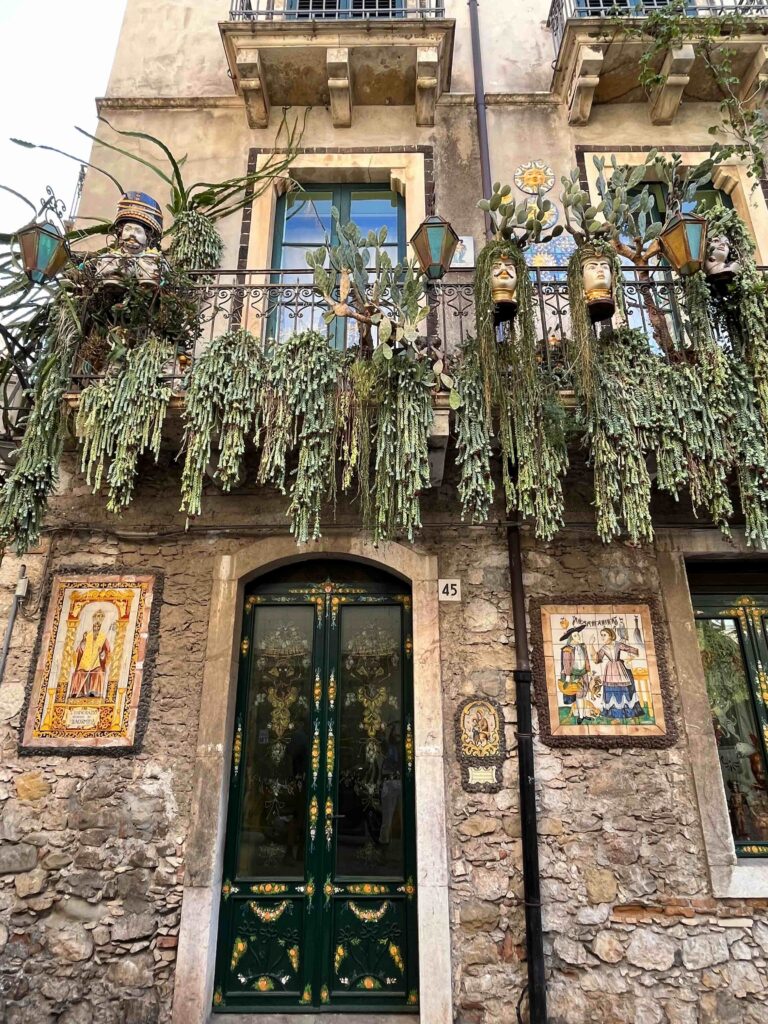
Teatro Greco
After breakfast, your first stop is the ancient Teatro Greco. I suggest going directly there after breakfast, as it gets crowded by late morning. This ancient Greek theatre, dating back to the third century BC offers breathtaking views of the Ionian Sea and Mount Etna. Renowned for its remarkable preservation and striking acoustics, the theatre was ingeniously designed to harness the natural landscape, enhancing the theatrical experience. Over the centuries, it evolved from its original Greek origins to incorporate Roman architectural elements, reflecting the layered history of Sicily itself.
Today, the Teatro Greco is a vibrant venue that hosts a variety of events, including operas, concerts, and the prestigious Taormina Film Fest. Check the Taormina event calendar when you are in town. Attending an open air concert in the theater, with a sunset view over Etna and the sea is an experience not to be missed.
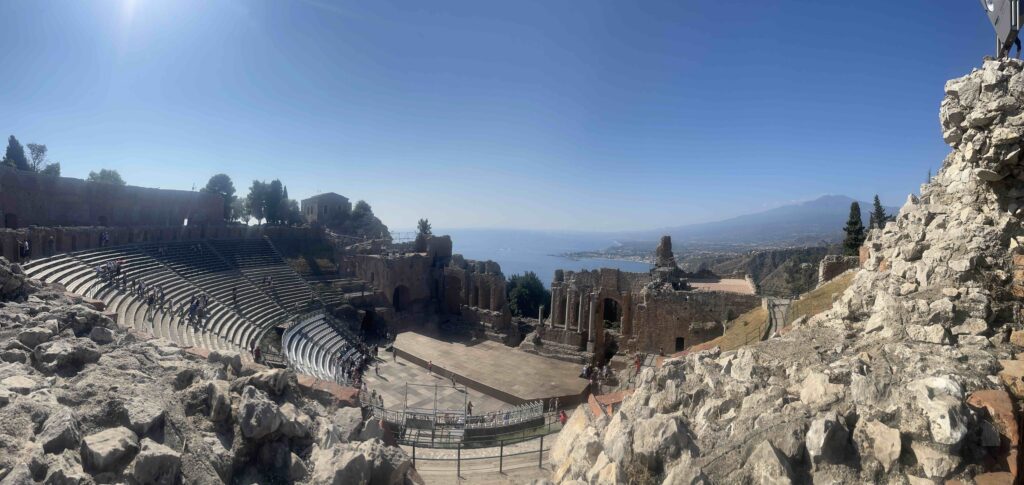
Corso Umberto
Next, take a leisurely stroll through Corso Umberto, which runs from Porta Messina to Porta Catania. This vibrant street, flanked by medieval buildings, is the soul of the town. Here you can meander through the array of chic boutiques, artisanal shops, and quaint cafés. We enjoyed shopping for local ceramics and textiles here. Be sure to spend time at the Piazza IX Aprile, Torre dell’Otologio (clock tower), and the Piazza Duomo. The Duomo cathedral is dedicated to Saint Nicholas of Bari and dates back to the 13th century.

Day 1 Afternoon: Villa Comunale, Mazzarò Beach
As you continue your explorations on Corso Umberto, head off main thoroughfare to find a spot for lunch. If you are looking for a quick bite to eat, try Rosticceria Da Cristina, with its excellent Arancini (rice balls). A few other good options frequented by locals are Osteria Da Rita Di Bille’ SAS and Arco Rosso.
Villa Comunale
After lunch, you’ll take a break from the crowds and head to Villa Comunale, the public gardens of Taormina, which are also known as Parco Duca Di Cesarò. Gifted to the public by the Scottish noblewoman Lady Florence Trevelyan in the early 20th century, these gardens have a collection of Mediterranean plants. Perched on a promontory, the gardens boast panoramic views of the Ionian Sea and Mount Etna.

Mazzarò Beach
If you have the energy and time after the gardens, head down to Mazzarò Beach, nestled at the foot of Taormina. Accessible via the Funivia (cable car ride) from the heart of Taormina, we recommend Mazzarò Beach for relaxation, snorkeling or boat tours. You can pay for a chair at a lido to access the private areas of the beach, or you can swim from the smaller public section.
The surrounding area is dotted with charming eateries and beach bars, where you can enjoy fresh seafood and local delicacies. Wrap up your day with a dinner in the Mazzarò area on the water, or head back up to Taormina for a concert at the Greek theater.
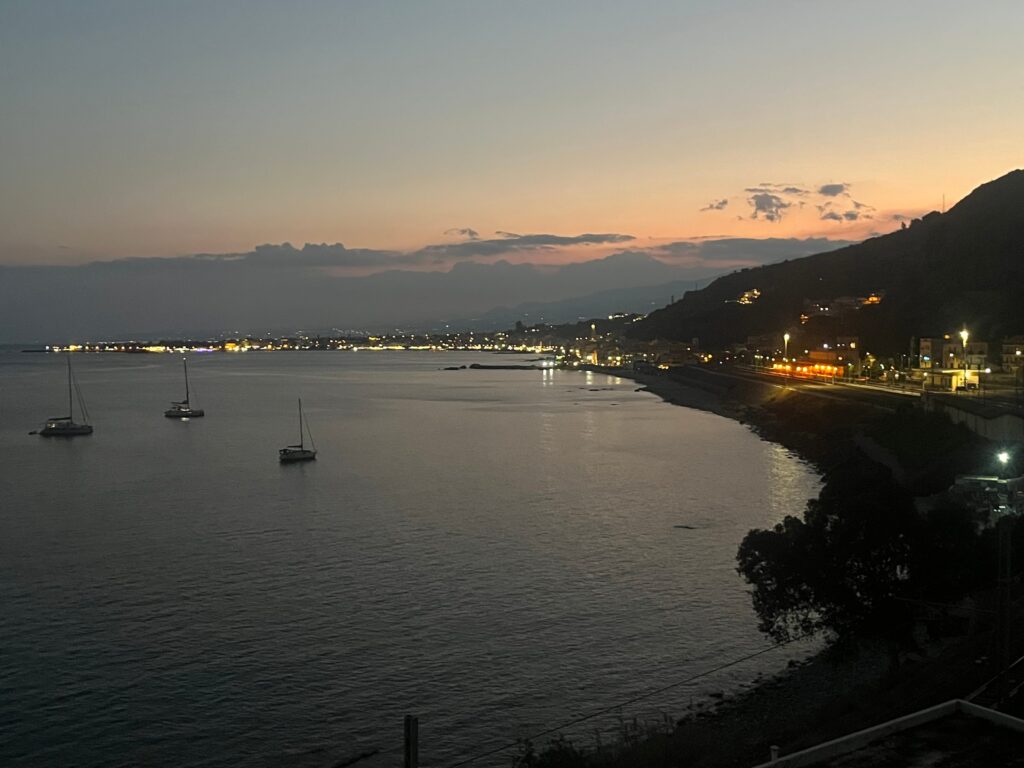
Day 2 Morning: Madonna della Rocca Sanctuary and Castelmola
Start the second day of your East Sicily travel itinerary exploring the Sanctuary of Madonna della Rocca and the charming village of Castelmola. Perched on a rocky crag, the Sanctuary of Madonna della Rocca, has a modest chapel carved directly into the rock. The sanctuary is accessible via a 800 meter steep but rewarding path, with 500 stairs. It is possible to take a bus from Taormina instead of hiking (or ask the taxi to stop here en route to Castelmola). This sacred site, dedicated to the Madonna, provides a spiritual respite and stunning views over Taormina and the Ionian Sea.
Continuing the ascent (on foot or by bus), you’ll reach Castelmola. Castelmola boasts narrow winding streets, artisanal shops, and traditional cafés. This hidden gem offers a glimpse into Sicilian life, away from the hustle and bustle of Taormina. The terraces of Castelmola offer unrivaled views that stretch from the rugged coastlines to Mount Etna.
If you’re feeling motivated, hike up to Monte Veneretta, where you will find stunning views over the sea. A great spot in Castelmola for lunch is Gallo Cedrone. Alternatively, you can eat lunch at the beach when you get to Isola Bella. If Castelmola and a bit of hiking is not for you, you may prefer spending another morning exploring Taormina.
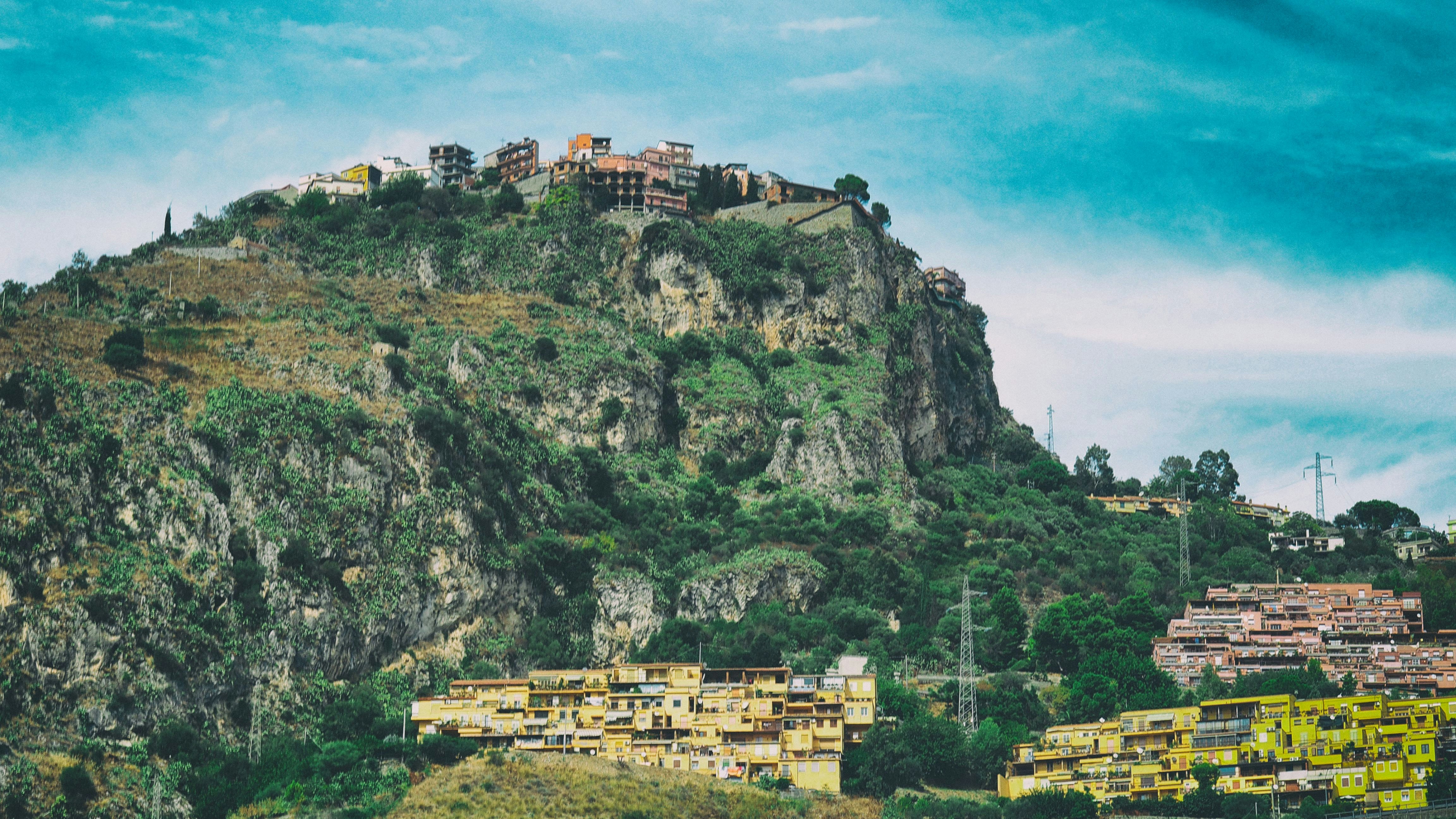
Day 2 Afternoon: Isola Bella
You’ll head down to Isola Bella next, either via Funivia, by bus, or on foot (1 hour walk). If you haven’t had lunch yet, we enjoyed our lunch at Pizzichella Ristorante Lido, which is on the left when you reach Isola Bella beach.
Isola Bella, or “beautiful island,” is a tiny island, connected to the mainland by a narrow strip of beach. Protected as a nature reserve, Isola Bella is a sanctuary for various species of birds and marine life, surrounded by crystal-clear waters that are great for snorkeling and swimming. You can wander through the island’s lush pathways, discovering hidden coves and the remnants of a small house. Don’t forget to bring water shoes; they do sell some cheap water shoes on the stairs on the way down to the beach in case you forget them.
The surrounding sea offers a refreshing escape from the heat. Watch out for jellyfish in the waters. I was stung while snorkeling. It wasn’t too painful, but it is something to look out for. Kayaking and boat tours are available. If you want a quiet spot to relax near the water but away from the crowds, try renting a chair at a lido (we got ours at Pizzichella Ristorante Lido after lunch).
Getting to Isola Bella
To get to Isola Bella, you have a few options:
- Recommended: take the Funivia (cable car), which costs 6 Euros roundtrip, to sea level in Mazzaro. It runs every 15 minutes, and gives you a stunning view over Isola Bella. When you arrive, you’ll have a short walk to get to Isola Bella.
- Alternatively, you can walk the whole way down, which took us 30 minutes. This does mean walking down quite a few steep stairs.
- Take a bus from Taormina via Luigi Pirandello to Taormina Capo, which costs 1.50 Euros and takes about 10 minutes. You’ll have a 0.6 mile (1 km) walk from there to get to Isola Bella.
- Take a taxi directly to Isola Bella, which costs 17-20 Euros.
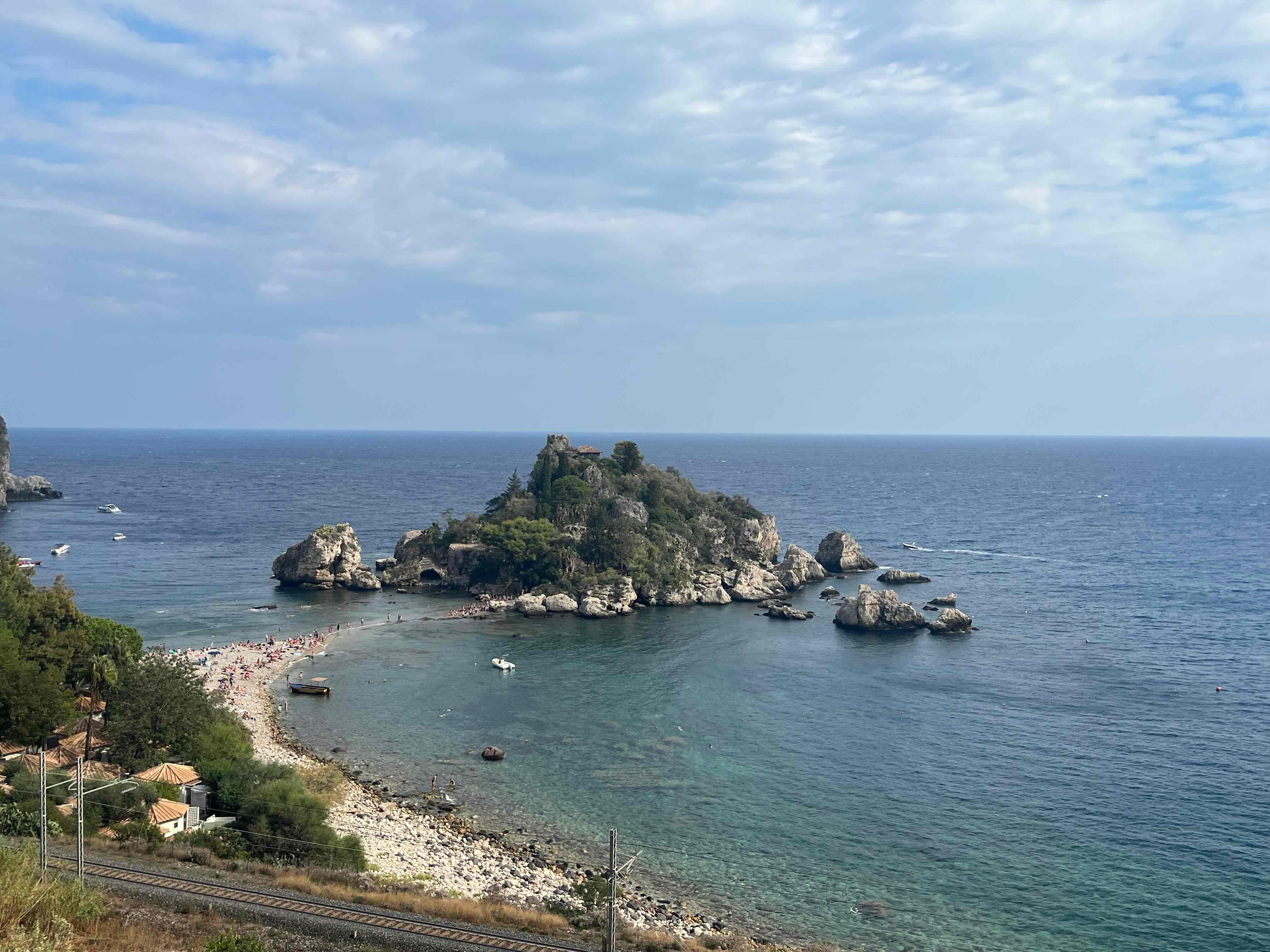
Day 3: Exploring Mount Etna
Mount Etna, which is Europe’s most active volcano, is a UNESCO World Heritage site offering an unparalleled experience for nature enthusiasts and adventurers alike. You’ll see ancient lava flows, rugged craters, and ash-covered plains. The altitudinal zones vary from lush forests to barren moonscapes near the summit.
While there are options for exploring independently, I’d recommend taking a tour for a few reasons. First, you can arrange for pickup and drop-off at your lodging in Taormina or Catania with many of the tours. Additionally, we learned so much about Etna from our guide that we otherwise would have missed.
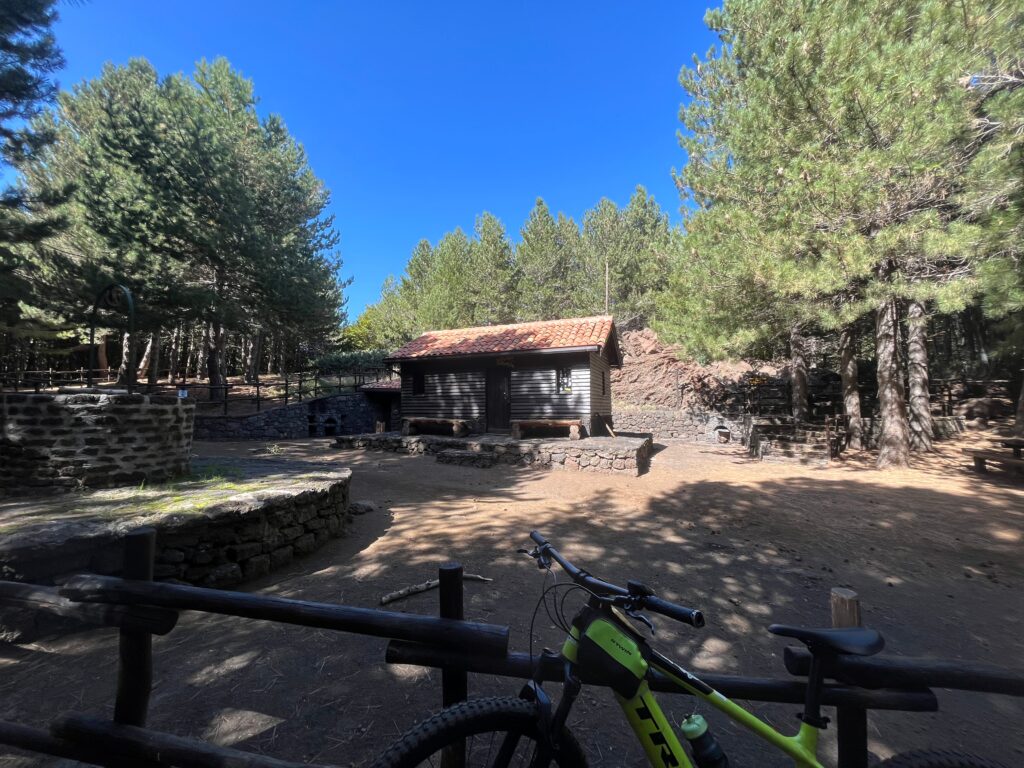
Exploring Independently
There are a number of options if you are hiking independently.
- Take the cable car from 1900 meters to the summit station at 2500 meters. 2024 prices are 50 Euros for adults, 30 Euros for 5-10 year old children. From 2500 meters, you can take a self-guided tour of this area.
- Take the cable car to 2500 meters, then a 4×4 vehicle ride to 2900 meters. 2024 prices for the cable car + 4×4 ride are 78 Euros for adults, 50 Euros for 5-10 year old children, This also includes a 60 minute walk with a guide. Self-guided tours are not an option over 2800 meters.
- Neither of these options gives you access to the active craters on top. For this, you need a guided tour.
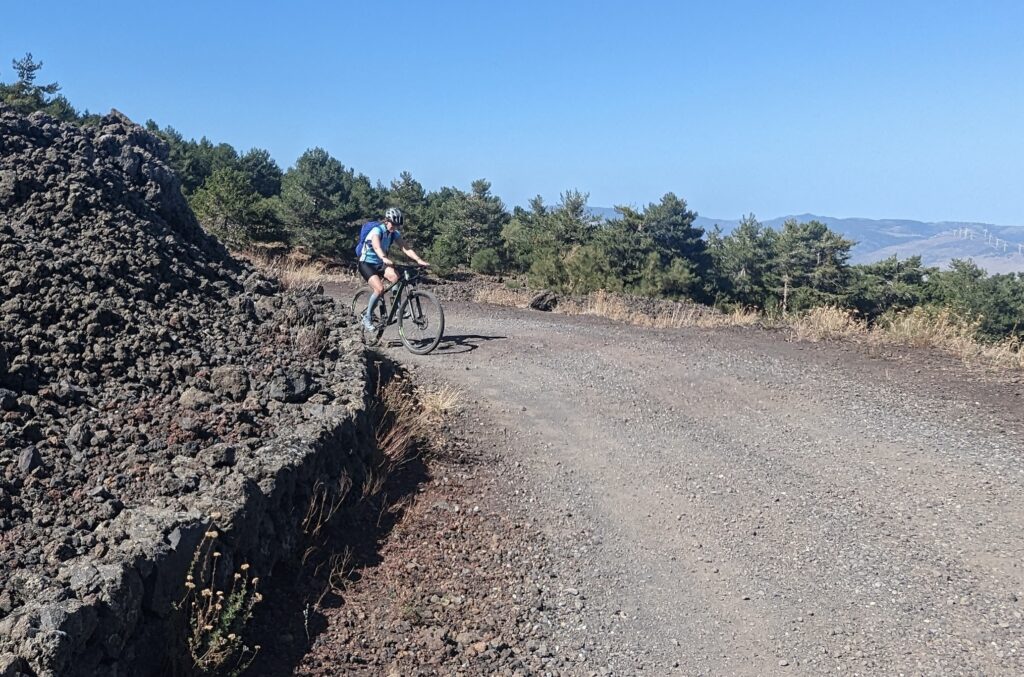
Guided Tours of Etna
Whether your goal is to visit the top of Etna or not, most people opt for a guided tour of Etna. They don’t cost much more than the cable car tickets, and provide insights into the history and flora and fauna local to Etna. Be sure to read the inclusions and exclusions carefully; some tours include cable car tickets, transfers, and lunch. Others don’t.
I’ve included our recommended tours here.
- Mt Etna E-bike Half-day Tour
- Volcano Craters Hiking Tour
- Half-day Etna Morning Jeep Tour
- Private Tour in a 4×4 from Taormina
- Full Day Etna, Wine, and Alcantara Canyons Tour: This top rated tour includes transport from Taormina, and includes a stop at the gorgeous Alcantara Gorge.
For a more in depth look at our recent bike tour on Etna, see our post How to find safe havens for cycling in Sicily.

3 Days in Syracuse
Day 4 Morning: Archaeological Park of Neapolis
You’ll spend the 4th day of your East Sicily travel itinerary in Syracuse. Syracuse was one of the major powers of the Mediterranean world and is home to a vast archaeological park featuring Greek and Roman ruins, the Archaeological Park of Neapolis. You’ll spend the morning visiting the park. You can walk over or opt to rent bikes to get there. Don’t miss these sites in the park:
- Greek Theatre, one of the largest of its kind, carved out of the rock face;
- Ear of Dionysius, a limestone cave famous for its unique acoustics;
- Roman Amphitheatre, one of the best preserved archaeological sites, where gladiators once battled.
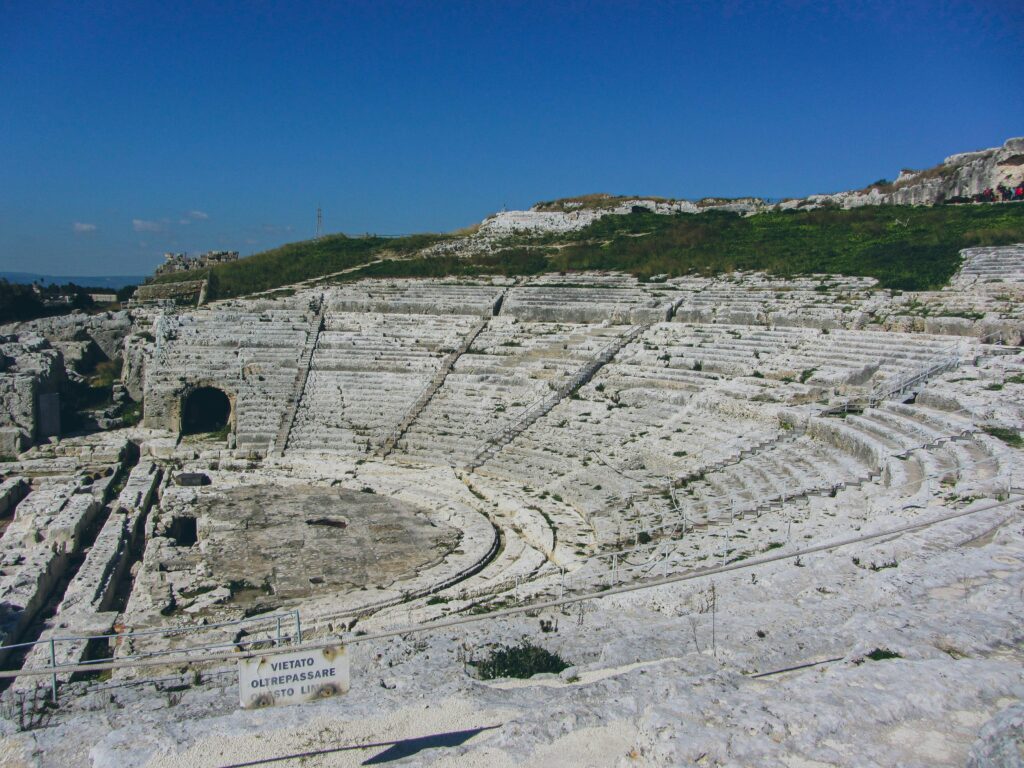

If you are interested in a tour, we recommend the Ancient Syracuse: private guided tour of the Neapolis archaeological park.
Day 4 Afternoon: Pista Ciclabile Siracusa
After finishing your tour of the park, head back into Syracuse and grab a picnic lunch to take along on your ride on the Pista Ciclabile Siracusa. The cycle path is built on the old Targia railway, and runs about 7 km (4.3 miles) from end to end (14 km or 8.6 miles roundtrip). While it’s short, it is scenic and has some great stopping points for a swim or picnic. We rented our bikes through Noleggio biciclette Siracusa.
The bike path starts at the African war memorial, where you head out on the crushed gravel trail. There are many spots to stop and walk down to the sea. Our favorite stop was at the ruins at the Tonnara di Santa Panagia, where we had a picnic and went swimming.
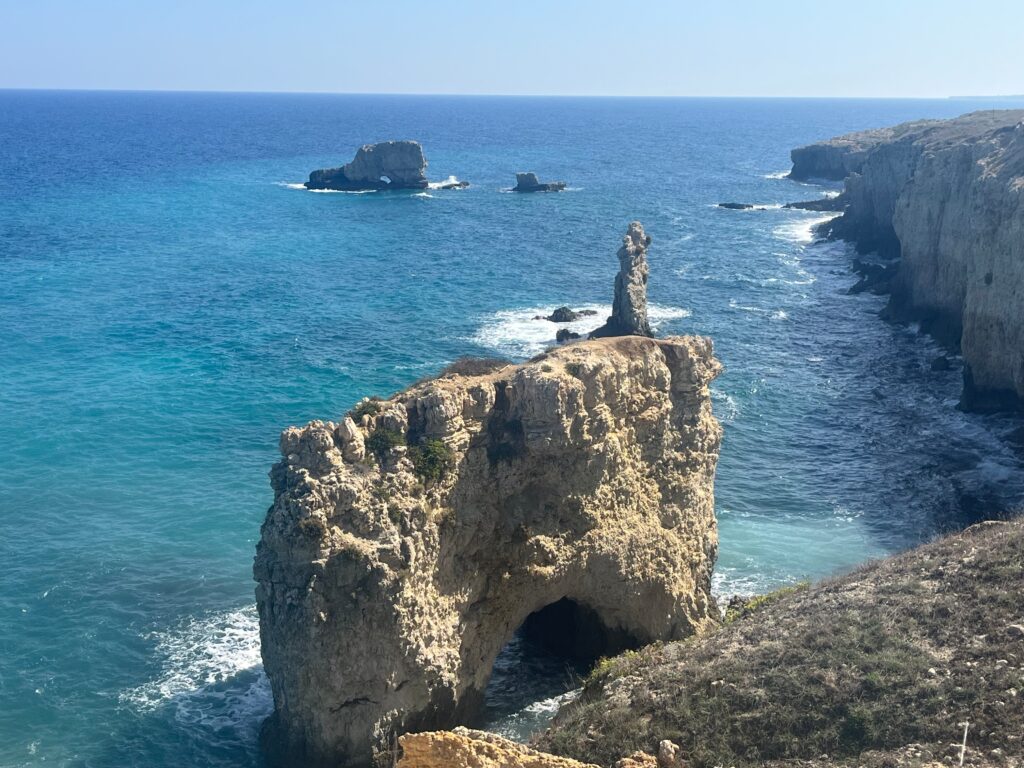
Though we biked on our own, we ran into a couple taking this bike tour, who had a great experience with their guide. If you are interested in more bike rides in Sicily, check out our post on How to Find Safe Havens for Biking in Sicily.
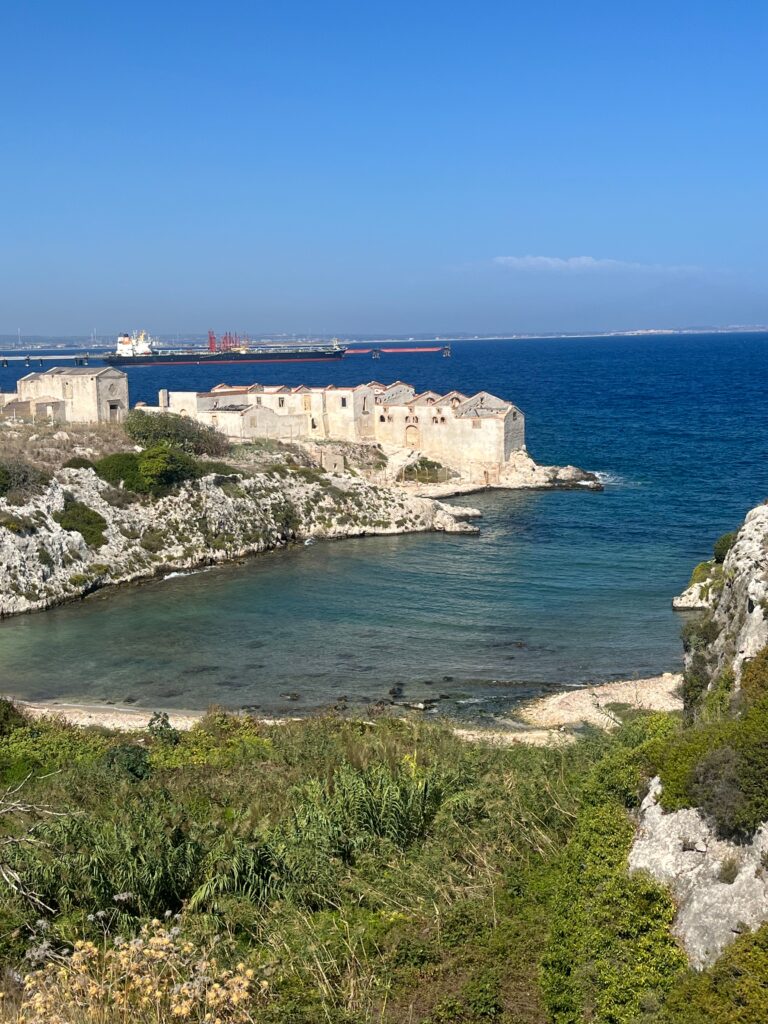
Day 5 Morning: Ortigia Market and Duomo
Start your visit to Ortigia, the historic center of Syracuse, at the daily market (closed on Sundays). Here you’ll join locals shopping for everything from fruit and vegetables, bread and pastries, fresh seafood, cheese, and more. This is a great place to get coffee and pastries for a breakfast or mid-morning break. A wonderful way to visit the market and learn more about the local culture and cuisine is to take a morning Market tour with a cooking class and lunch. We didn’t have a chance to do this but heard great things about the experience.
Take a leisurely stroll along the narrow streets and waterfront promenades, soaking in the atmosphere. Stop by the Piazza del Duomo to admire the stunning Cathedral of Syracuse. This is a great spot for people watching while sitting at a café. Don’t miss also the Temple of Apollo and the Fontana di Diana in Piazza Archimede.
Day 5 Afternoon: Ortigia
One of our favorite spots in Ortigia for lunch is Bistro 18. The Mediterranean food was excellent and the owners were super friendly and welcoming. We weren’t the only guests commenting that this was the best meal we had in Sicily.
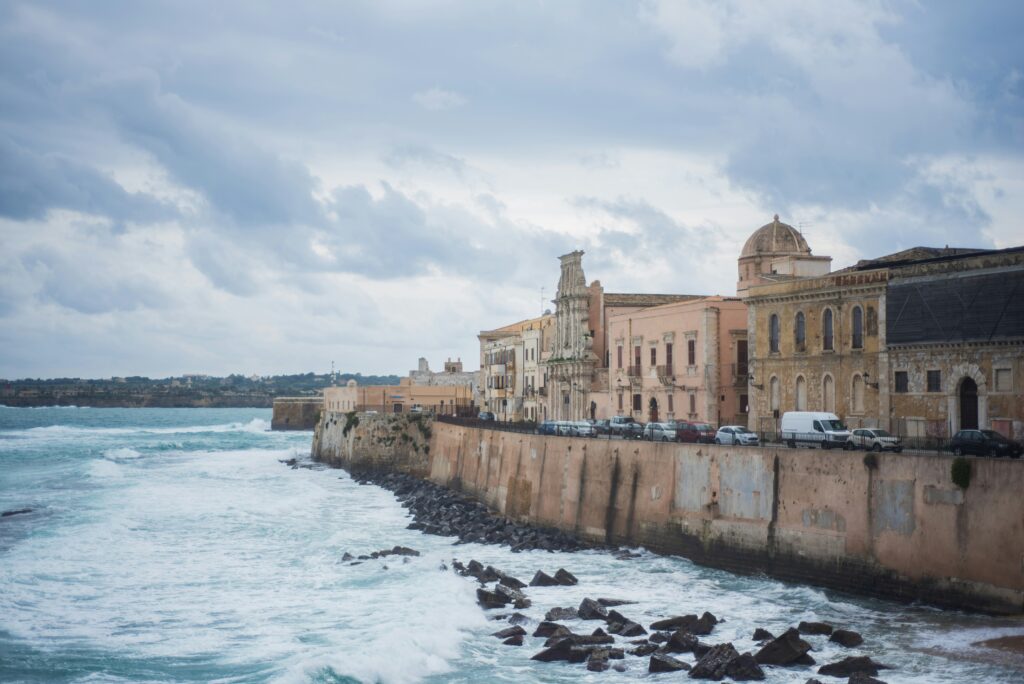
Post-lunch, head to the imposing Maniace Castle, situated at the tip of Ortigia. This fortress, constructed between 1232 and 1240 by the Emperor Frederick II, offers panoramic views of the sea and the city. A short walk from the castle leads you to the Fountain of Arethusa, a freshwater spring surrounded by papyrus plants, with a legend that dates back to Greek mythology.
Take a break to cool down either at the small Ortigia beach or one of numerous swimming platforms. As the day winds down, find a spot along the waterfront to watch the sun dip below the horizon, painting the sky in shades of pink and orange. A few spots we’d recommend to watch the sunset are just above the Fountain of Arethusa and the Mikatú wine bar.
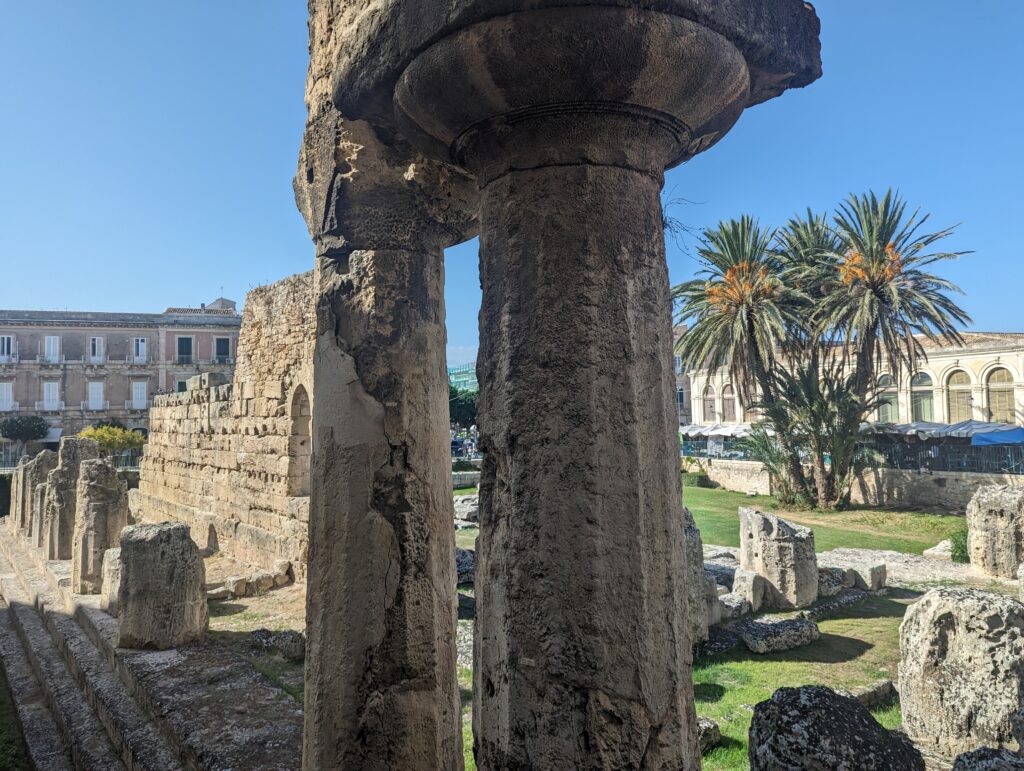
Day 6: Day trip to Noto
You’ll spend the 6th day of your East Sicily travel itinerary in Noto. You can drive in 30 minutes or take the train in 35 minutes, making this an easy day trip. Noto is a UNESCO World Heritage site and is known for being a baroque masterpiece. It was meticulously rebuilt in the early 18th century following a devastating earthquake. You’ll notice the contrast between the historical charm of Ortigia and Noto’s consistent baroque style.
Upon arrival, explore Corso Vittorio Emanuele, Noto’s main street. You’ll find stunning palaces, churches, and ornate balconies along this promenade. A highlight of Noto is the Cathedral of San Nicolò, which re-opened in 2007 after the collapse of the cathedral’s dome in 1997 and subsequent restoration.
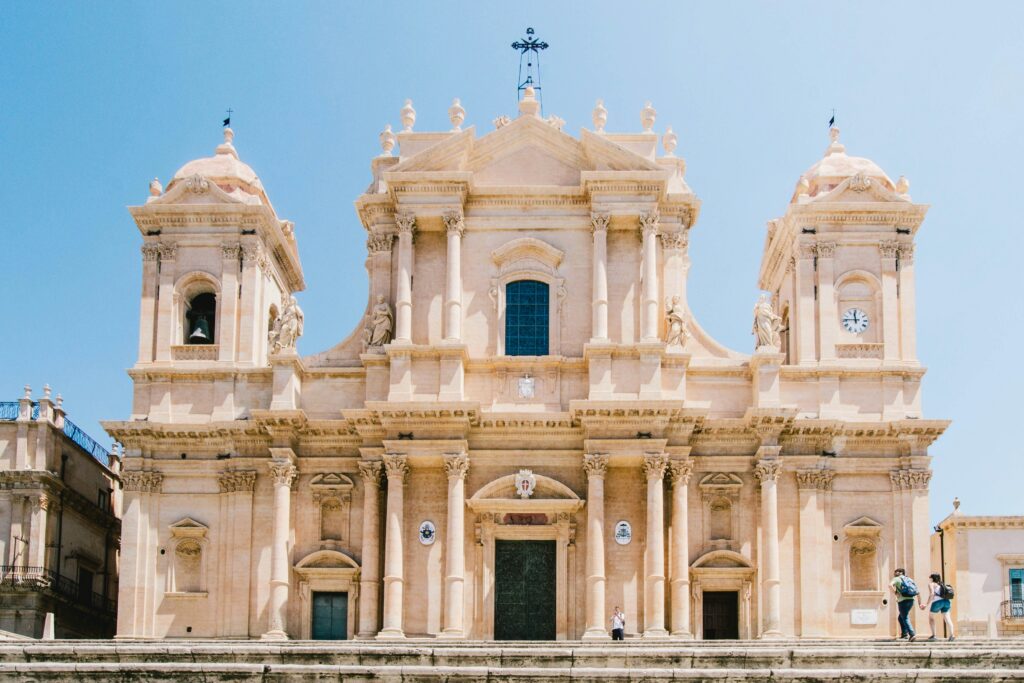
After touring the cathedral, visit the Palazzo Ducezio with its Hall of Mirrors and the Church of San Carlo al Corso. Each offers a unique glimpse into the opulence and grandeur of baroque design. The beauty of Noto is not just in its structures but also in the lively atmosphere of its streets. Be sure to try the Sicilian almond pastries (Mandorla di Noto) while in town.
If you have enough time, visit the Vendicari Reserve. Here you can explore Byzantine ruins dating from the 6th century A.D. and stop and swim at stunning beaches.
If you are interested in a Noto tour, with transportation included from Syracuse, look at this Noto 1/2 Day Tour. Alternatively, this full day tour may be of interest, as it also stops in Ragusa and Modica: From Syracuse: Ragusa Ibla, Noto and Modica Private Day Trip.
Day 7: Catania
You will most likely fly into or out of Catania. I’d suggest spending the 1st or last night in Catania, taking advantage of this to spend a half-day explore the city. As Sicily’s second-largest city, the city’s streets are lined with baroque buildings constructed from black lava stone, giving it a distinctive and striking appearance.
At the heart of Catania, the Piazza del Duomo is an architectural marvel, home to the city’s symbol, the Elephant Fountain, and the imposing Cathedral of Saint Agatha. Spend time exploring the bustling fish market, La Pescheria, gaining insights into daily life in Catania. Visit the Monastero dei Benedettini, now a university, and take their 90-minute guided tour. If time allows, explore the Teatro Romano di Catania, one of two Roman Theaters in the city.

Tips for your East Sicily Travel Itinerary
Where to Stay in Taormina
Most visitors stay either in town in Taormina (on the hill) or on the waterfront in Giardini Naxos. Taormina accommodations are more expensive, but also better located for restaurants and access to the sites in town. The main downsides are the crowds of tourists and the time it takes to get to the beach. Giardini Naxos, on the other hand, is a small town directly on the sea, with plenty of local restaurants to choose from. Buses run frequently up to Taormina, making this a convenient, affordable alternative. We chose to stay in Taormina, though along the water, a 20 minute walk up a steep hill to town, This kept us away from the crowds and close to the water.
Our recommended accommodations:
- Vacation rentals on the water (the area we stayed and would recommend): Miriam’s Seafront Apartment
- Luxury: San Domenico Palace, Taormina, A Four Seasons Hotel with some of the best views over Etna and the sea
- Luxury; Hotel Villa Belvedere: classic Taormina hotel
- Moderate: B&B Re Tancredi: B&B with character and wonderful location in town
- Budget: B&B Antonella
Where to Stay in Syracuse
You have a choice in Syracuse of staying on the historic island of Ortigia or on the newer Syracuse side. The main car parks are in Syracuse. To experience the historic charm, we would recommend staying in Ortigia.
Our recommended accommodations:
- Luxury: Grand Hotel Des Etrangers
- Luxury: Ortea Palace Hotel, Sicily, Autograph Collection
- Moderate: Domus Mariae Albergo
- Moderate: Corinzia Casa Vacanze
- Budget: Residence Le Tre Piazze
- Budget: Casa Vacanze Parco Archeologico
Travel within East Sicily
We found it easiest to rent a car, though driving in Sicily isn’t for the faint of heart. You might like to read our post Renting a Car in Sicily: Things to Know Before You Go before deciding whether to rent a car in Sicily or not. Alternatively, plan for transfers or take public transport between towns, and sign up for day tours for your Etna and Noto day trips.
- Catania-Fontanarossa Airport to Taormina: Taormina is less than an hour drive. A bus or train takes about an hour and 20 minutes. From Catania, visitors have several options to reach Taormina. If you choose to take a train, you’ll go to Taormina-Giardini station, and will need to take a taxi or bus up to Taormina town.
You can book a direct airport transfer here. - Taormina to Syracuse: driving a car and taking the direct bus takes less than 2 hours. The train takes longer since it involves a change in Catania.
- Syracuse to Catania: this is a 50 minute car or bus ride. Trains do run directly to Catania, taking a little more than an hour.
If you are planning a trip to Sicily, you may like our other Sicily guides:
- How to Plan your Week in Western Sicily Away from the Crowds
- How to Find Safe Havens for Sicily Bike Travel
- Egadi Islands, Italy: Levanzo Day Trip
- Renting a Car in Sicily: Things to Know Before You Go
- One Day in Syracuse, Sicily
- Favignana Day Trip: Exploring the Butterfly Island
- Day Trip Mt. Etna: An Adventure Like No Other
IF YOU LIKE THIS POST, PIN IT FOR LATER!
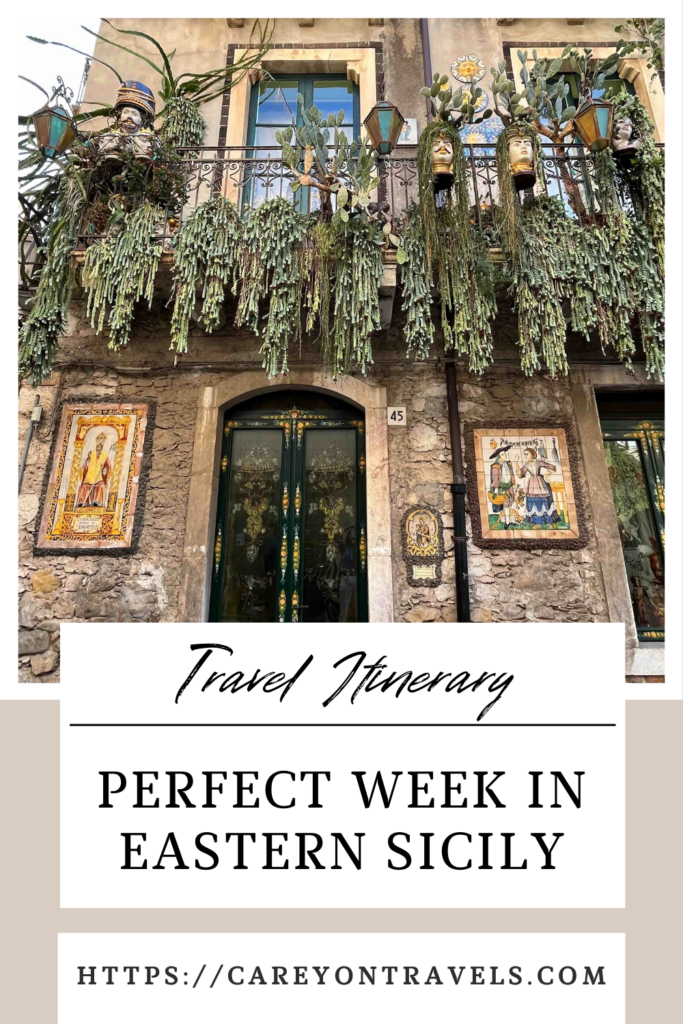
Travel Resources
Our preferred travel booking sites are below.
| Air Travel | CheapOair |
| Lodging | Booking.com, VRBO.com, Expedia.com, Hostelworld |
| Tours and Activities | Viator.com, GetYourGuide.com |
| Car rentals | Discovercars.com |
| Travel insurance | Squaremouth |
| Bike and scooter rentals | BikeBookings.com |
| Train tickets | Trainline |


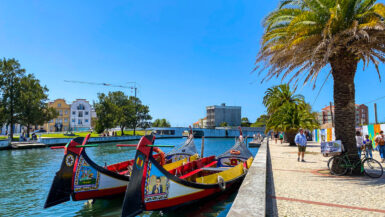

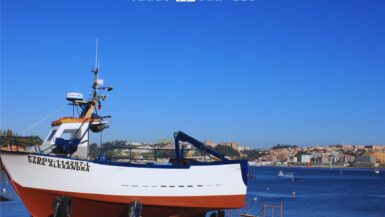
[…] people visit Taormina as part of a larger Eastern Sicily itinerary. You can easily spend 2-3 days in Taormina, exploring more of the town, and the surrounding areas, […]
Aside from the gorgeous architecture, I would love to visit the Ortigia Market. Thanks for the tip that it’s closed on Sundays!
Thanks for the feedback. Hope you can make it to Ortigia.
I can’t get over the stunning architecture but really those views are amazing… the Pista Ciclabile Siracusa looks sooo nice!! Great Sicily ideas.
The architecture is stunning, and the variety of architectural styles was incredible.
We had an amazing trip to Sicily last year. This post brought back some great memories. And highlighted that we missed a few spots like Castelmola. We stayed outside of Taormina and I am sure did not get the same experience as staying closer. And we sure could have used more time in Syracusa.
There is always more to see, but all the more reason to plan a return visit :-). We missed going out to Stromboli, which we really wanted to see.
Such a ruggedly beautiful part of Sicily. It just reeks of history. Your photos are stunning. The photo you chose for your pin has me going on all kinds of crazy pot/plant ideas!!
Thanks, I loved the house overflowing with plants!
Thank you so much for this post. My family is from Sicily, and visiting is at the top of my bucket list. I knew I wanted to visit Taormina, but this post has given me so many ideas on what to do/see. The market in Ortigia is going to be a must, along with a cooking class.
I hope you are able to visit. We loved the western half of Sicily too. I included an itinerary for that too at https://careyontravels.com/plan-your-week-in-western-sicily/.
What a thorough post with tons of great info and well planned out so as not to waste time! I would center everything about that amazing food!
I agree, the food in Sicily is incredible. I love fresh seafood, so that was the highlight for me. But, arancini, granitas, and most everything we tried there was amazing.